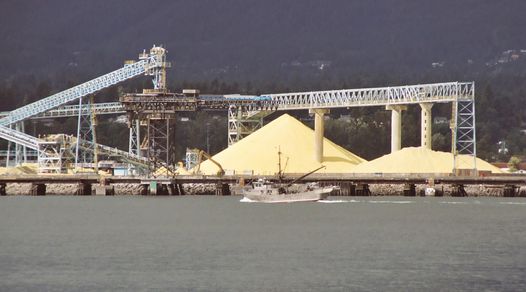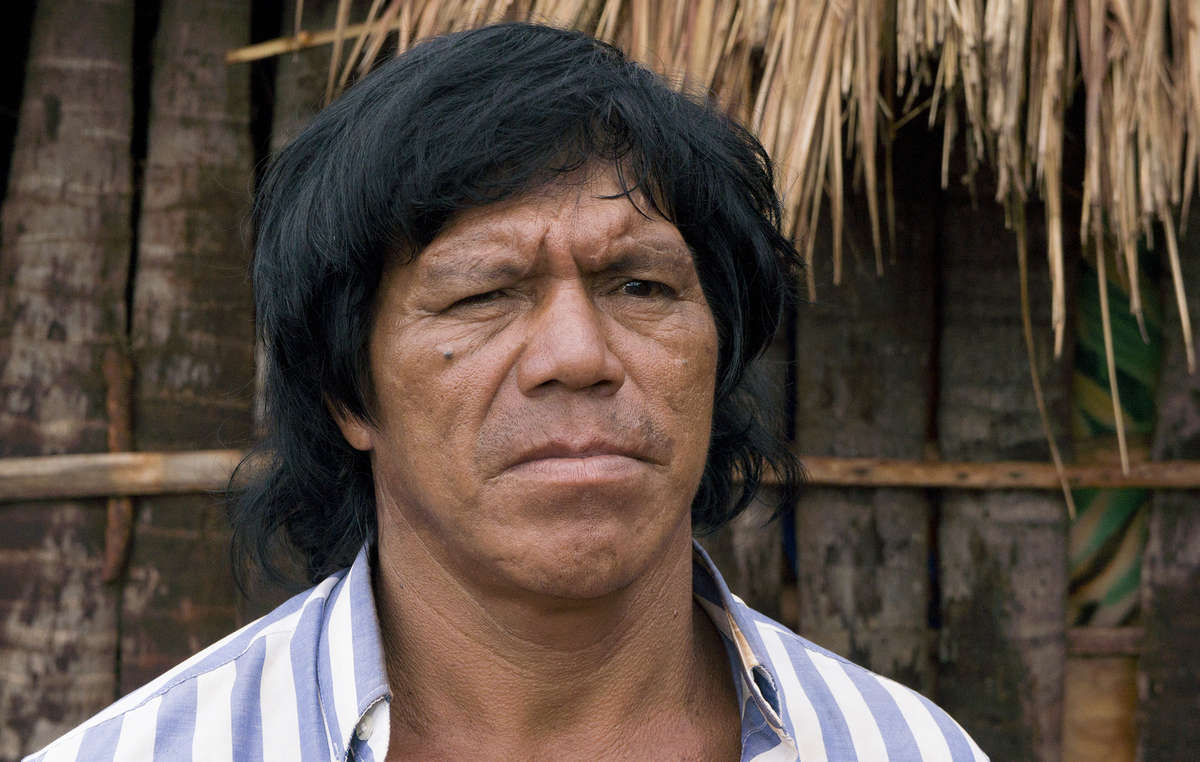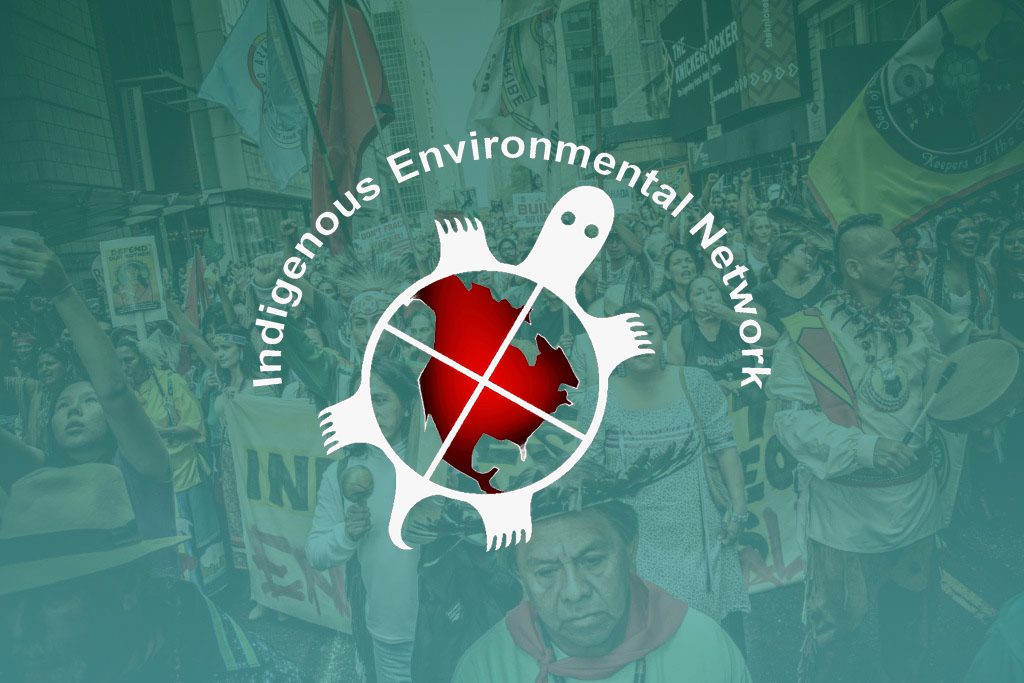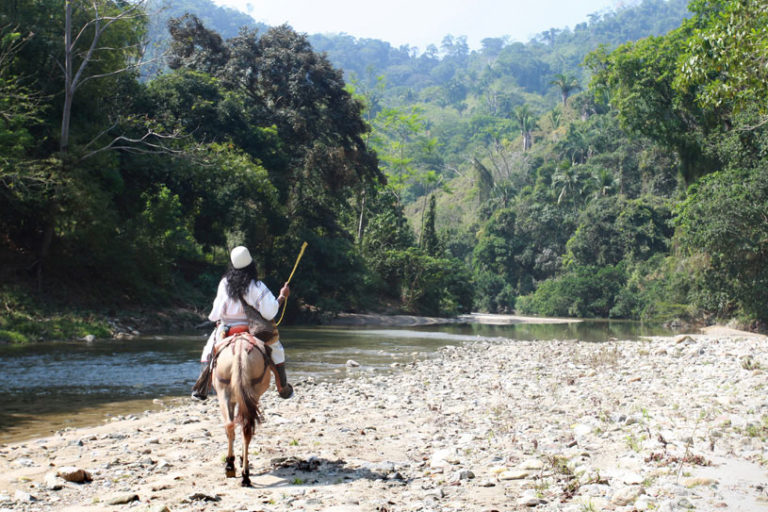
Recognizing the true guardians of the forest: Q&A with David Kaimowitz
by DGR News Service | Apr 23, 2021 | Agriculture, Biodiversity & Habitat Destruction, Climate Change, Colonialism & Conquest, Indigenous Autonomy, Mining & Drilling, Movement Building & Support, Repression at Home, Toxification
Indigenous peoples worldwide are the victims of the largest genocide in human history, which is ongoing. Wherever indigenous cultures have not been completely destroyed or assimilated, they stand as relentless defenders of the landbases and natural communities which are there ancestral homes. They also provide living proof that humans as a species are not inherently destructive, but a societal structure based on large scale monoculture, endless energy consumption, accumulation of wealth and power for a few elites, human supremacy and patriarchy (i.e. civilization) is. DGR stands in strong solidarity with indigenous peoples.
This article originally appeared on Mongabay.
by Rhett A. Butler on 14 April 2021
- David Kaimowitz describes his career as a “a 30-year quest to understand what causes deforestation,” one that has brought him full circle to where he started: at the issue of land rights.
- Kaimowitz, who heads the Forest and Farm Facility, based at FAO, says the evidence shows that secure communal tenure rights is one of the most cost-effective ways to curb deforestation.
- In that time, he’s also seen the discourse around the drivers of deforestation change from blaming smallholders, to realizing that a handful of large commodities companies are responsible for the majority of tropical forest loss.
- In an interview with Mongabay founder Rhett A. Butler, Kaimowitz talks about why it took so long for Indigenous people to be recognized as guardians of the forest, the need for conservation NGOs to address social justice, and society’s capacity to effect meaningful change.
Over the past 20 years, the conservation sector has increasingly recognized the contributions Indigenous communities have made toward achieving conservation goals, including protecting biodiversity and maintaining ecosystems that sustain us. Accordingly, some large conservation NGOs that a generation ago were heavily focused on establishing and fortifying protected areas are today advocating for Indigenous rights and helping communities secure land tenure.
As a researcher who has worked at the intersection of forests, agriculture and local communities for more than 30 years now, David Kaimowitz has been well-positioned to observe the recent evolution of the conservation sector’s relationship with such communities.
“Indigenous Peoples and local communities have increasingly been recast as heroes, rather than villains,” said Kaimowitz, who currently serves as the manager of the Forest and Farm Facility, a partnership between the the U.N.’s Food and Agriculture Organization (FAO), the IUCN, the International Institute for Environment and Development (IIED), and the AgriCord Alliance. He attributes this shift to three factors: changing realities on the ground, a growing body of evidence, and better messaging.
“As more and more forest not managed by Indigenous Peoples and local communities disappears, the conservation community has realized that increasingly these are the only forests left; at least, the only intact forests with large undisturbed areas,” Kaimowitz told Mongabay. “A growing [amount of] literature showed that, given a favorable policy environment, Indigenous Peoples and local communities often manage common property forests and other natural resources sustainably.
“The Indigenous Peoples and forest community groups themselves have become more effective at getting their messages across and making their voices heard. They have become powerful political forces in many countries and on the global stage, and conservation groups have had to listen.”
But while conservation is changing, it hasn’t yet been transformed: Indigenous peoples and local communities still face marginalization, lack of meaningful engagement, and underrepresentation, especially in conservation decision-making an leadership roles. Kaimowitz says conservation organizations need to become more inclusive.
“The more these organizations reflect the true diversity of the broader societies, the better they will be able to do that,” he said.
“Conservation has two strong long-standing strains. One harks back to nobles and moguls, who wanted to stop villagers from poaching big animals they hunted for trophies. The other finds its voice among those who depend on (and often nurture) nature to survive. The question is who will speak for conservation? The sheriff of Nottingham, protecting his majesty’s fowl and game, or Robin Hood, with his merry men (and women), living in the forest. That same unresolved tensions persist today; and will determine the movements’ future.”
In parts of the world, those tensions have been heightened by the COVID-19 pandemic, which led some international conservation groups to pull out of projects, triggered a collapse in ecotourism, disrupted access to markets and the flow of remittances, and led some city dwellers to return to the countryside to farm. In some places, those developments have pushed local communities to take up subsistence farming and hunting in protected areas or become poachers, putting them in conflict with conservationists.

The pandemic, says Kaimowitz, has been devastating to local communities, causing “profound pain” and loss of traditional knowledge with the death of elders. But COVID-19 has also shown us that governments are capable of taking dramatic action when facing a crisis.
“If the pandemic proves anything, it is that political and economic elites can take extraordinary measures to stave off disaster if they decide to do so,” he said. “Many things that ‘could not be done’ suddenly were. Central banks and ministries of finance pulled out their checkbooks and spent money they supposedly did not have. Both governments and the broader society stepped up to the plate. It has not been smooth or easy, but the world has largely pulled back from the abyss.
“Something similar will have to happen to avert catastrophic climate change and biodiversity loss; and there are signs that elites are getting the message.”
Kaimowitz spoke about these issues and more during an April 2021 conversation with Mongabay founder Rhett A. Butler.
Mongabay: What sparked your interest in land rights and land use change?
David Kaimowitz: My whole life has revolved around an intertwined concern for social justice and the environment.
The land rights interest comes from undergraduate courses I took highlighting the huge inequalities in Latin American landholdings. It became clear that, in places where natural resources represent a large share of economic wealth, who owns and manages them influences every aspect of society.
We studied agrarian reforms in class, but I never imagined that one day I would be involved in one myself. Then, by pure coincidence, I entered a doctoral program in Wisconsin, just after the Nicaraguans overthrew the dictator Anastasio Somoza in 1979. The university had just gotten funding for a project with Nicaragua’s Ministry of Agricultural Development and Agrarian Reform (MIDINRA), and I became a research assistant. When Somoza fell, the Sandinistas took over many large farms and prominent experts flocked to the country to debate what to do with them. As a budding professional, it was an amazing opportunity to witness history being made.
Soon after, MIDINRA hired me directly, and we were asked to do oral histories of village elders in the northern Segovias region. The elders talked about major changes in how they farmed during their lifetime and the rapid loss of forest cover and soil fertility. That brought home how much daily life and the environment could change in a single lifetime.
Even so, I did not focus on land use change until the 1990s, when the United Nations held the Earth Summit in Rio de Janeiro and “sustainable development” became the buzzword. I had read about how government subsidies and burgeoning export markets for beef triggered mass forest clearing for pastures in Central America. But by 1994 the situation had changed, and the region’s livestock sector was in crisis. That made me wonder if high beef prices and subsidized credit bolstered deforestation, would low prices and no credit bring the forest back? (It turned out, not much; but that is a story for another day.)
This initial puzzle led to a 30-year quest to understand what causes deforestation. Ironically, that has now brought me back full circle, to land rights. Because the evidence shows that secure communal tenure rights is one of the most cost-effective ways to curb deforestation and people won’t restore forests unless they have rights to trees.
Mongabay: What is your current focus at the FAO?
David Kaimowitz: The realization that Indigenous Peoples and local communities’ land and forest rights were so important for protecting forests led me to champion the need for greater funding to that end. It turns out that such rights and community resource management are key for addressing many major global challenges, including climate change, biodiversity loss, social conflict, and rural poverty, as well as forest loss per se.
So, I left my job in forest research (at CIFOR) and moved to the Ford Foundation to fund this work. Much of my work centered on supporting Indigenous Peoples and community groups and convincing international agencies to do the same. Many colleagues at those agencies found the arguments compelling but did not know how they could fund that work. Some great new initiatives emerged, like the International Forest and Land Tenure Facility, Indigenous and community-managed territorial funds in Brazil, the Nia Tero Fund [Mongabay Interview with Nia Tero’s Peter Seligmann], and the World Bank’s Direct Grant Mechanism, but they were all tiny compared to the need.

So, I became manager of the Forest and Farm Facility so I could champion that cause. The Forest and Farm Facility is a partnership between the FAO, IUCN, IIED, and AgriCord, which supports forest and farm organizations in Africa, Asia, and Latin America, which has been doing great work since 2013. I saw an opportunity to build on that and demonstrate that international agencies can support rural grassroots organizations effectively and achieve results at scale.
The FFF focuses on improving rural livelihoods and resilience and promoting more climate and biodiversity friendly landscapes. We provide funding and technical support and advocate for local, national, regional, and global farmer, community forestry, and Indigenous Peoples organizations. We also help organizations strengthen their advocacy, community enterprises, and operations, with special attention to women’s rights and youth inclusion, and facilitate links between these rural membership organizations with other internationally funded programs and with private investors and buyers.
Mongabay: How are the drivers of deforestation different today than they were in the 1980s and 1990s?
David Kaimowitz: Not only have the drivers of deforestation changed since then, but people’s thinking has also changed. The discourse of the 1992 Earth Summit in Rio was that poverty drove deforestation. Environmental policies might be important, but ultimately the trick was to lift people out of poverty, so they would not have to overexploit their natural resources. While some talked about large cattle ranchers and logging companies, blame for deforestation was squarely on small-scale shifting cultivation.

That discourse probably overplayed the role of poverty and poor people in forest clearing even back then. Moving to forested regions, logging or clearing large forests and replacing them with crops or livestock requires more capital and labor than poor people usually have. It is true that clearing many small patches of forest can affect large areas — and we definitely see that in some regions — but that has always been responsible for a smaller portion of total tropical forest loss than many people thought.
In any case, since the 1990s large companies and landholders have played a more dominant role in global deforestation, both empirically and in the discourse. An increasing portion of deforestation has been linked to a small number of commodities — beef, palm oil, soy, and pulp and paper — where only a few hundred large companies dominate global value chains. The trend has been toward clearing larger areas (although this has varied over time and by region).

Mining, of various scales, and production of illicit crops and related money laundering have become much more prominent causes of deforestation. In contrast, commercial timber production has lost prominence in the discussion, in part because timber resources have largely been exhausted in many regions, especially in the dipterocarp and teak forests of Southeast Asia.
Small-scale shifting cultivation, logging, and charcoal and fuelwood collection have increasingly disappeared from the global agenda and have lost importance in many regions. The main exception has been Sub-Saharan Africa, where small farms and common property resources remain dominant and burgeoning urban markets for forest products sometimes fuel overexploitation.
Mongabay: You’ve been working at the intersection of forests, agriculture and local communities for more than 30 years now. In that time, what have been the biggest changes in this space?
David Kaimowitz: As I began to discuss earlier, both the drivers of forest loss and the narratives about them have changed. To some extent the narrative change reflected empirical trends, but it is more complex than that.
Indigenous Peoples and local communities have increasingly been recast as heroes, rather than villains. Studies from different regions of the world called into question alarmist reports about the fuelwood crisis, devastating effects of shifting cultivation, and the extent of small farmer deforestation more generally. The motives behind these discourses were also questioned and cataloged as neocolonial attempts to justify stripping poor families of their resources, as often occurred in colonial days.

A growing literature showed that, given a favorable policy environment, Indigenous Peoples and local communities often manage common property forests and other natural resources sustainably. Elinor Ostrom became the first woman (and first non-economist) to win the Nobel Prize in Economics in 2009 for demonstrating that, and it was a clear sign the tide had changed.
I recently wrote a report about forests in Indigenous and tribal territories in Latin America, published by FAO and FILAC, that cites dozens of relatively new studies that show that these territories’ inhabitants have generally managed their forests better than other groups. The most surprising thing about the peoples’ reaction to that conclusion was that no one was surprised. In a few decades, claiming that Indigenous Peoples were “guardians of the forests” went from being heresy to an established fact.
That is not to say that small farmers, or Indigenous Peoples for that matter, never destroy forests, or that it is not a problem when they do. Poor rural households clearly overexploit forest resources in some places, and the issue must be addressed. However, most experts now hold large-scale actors responsible for a majority of global tropical forest destruction and think it is better to work with communities to reduce smallholder overexploitation of forest resources, rather than repressing them.
Mongabay: Over the past decade, there seems to be much greater awareness in the conservation sector about the contributions Indigenous peoples and local communities have made toward achieving conservation outcomes. What has driven this shift?
David Kaimowitz: Part has to do with changing realities on the ground. As more and more forest not managed by Indigenous Peoples and local communities disappears, the conservation community has realized that increasingly these are the only forests left; at least, the only intact forests with large undisturbed areas.
Part also has to do with the avalanche of rigorous research highlighting those contributions. When I did my meta-analysis of research on forests in Indigenous and Afro-descendant territories in Latin America for the FAO-FILAC report, the sheer volume of high-quality recent research that all pointed in the same direction amazed me. These territories’ forests have been better preserved, even when accounting for things such as distance from roads and soil fertility. When the territories have formal rights and additional support, their forests are doing better still.
Finally, the Indigenous Peoples and forest community groups themselves have become more effective at getting their messages across and making their voices heard. They have become powerful political forces in many countries and on the global stage, and conservation groups have had to listen.
Mongabay: We’ve heard a lot more about stakeholder inclusivity in recent years, especially in the context of the past year between the social justice movement in the U.S. and criticisms of colonial practices among some big NGOs. Is this being translated at the levels of decision-making within the institutions that fund and implement conservation projects?
David Kaimowitz: The big conservation NGOs are large bureaucracies with strong institutional cultures, dominated by upper-middle-class whites, like me. In any such bureaucracy, transformative change rarely happens overnight. I do think, though, that the dramatic upswing of the racial justice movement in the United States and elsewhere, and the growing environmental justice movements have shaken them to their core. They have been forced to come to grips with sordid elements in their past, recognize implicit bias against people of color, and focus more on how environmental problems affect poor people and people of color disproportionately.
How far this will get is hard to say. Many previous efforts to get these organizations to address social and racial justice concerns petered out over time. But I am cautiously optimistic that this time will be different, and we will see real change. Many funders that support these organizations expect that.
Mongabay: What do you see as major gaps that still persist in the conservation sector?
David Kaimowitz: Most immediately, there are staffing issues, bringing in more people of color and from low-income households. But more broadly the question is, will they embrace an approach that is not so elite? Can they speak to regular peoples’ daily lives in ways that they can understand and respect those peoples’ lived experience and traditional knowledge, be they rural or urban? The more these organizations reflect the true diversity of the broader societies, the better they will be able to do that.

Conservation has two strong long-standing strains. One harks back to nobles and moguls, who wanted to stop villagers from poaching big animals they hunted for trophies. The other finds its voice among those who depend on (and often nurture) nature to survive. The question is who will speak for conservation? The sheriff of Nottingham, protecting his majesty’s fowl and game, or Robin Hood, with his merry men (and women), living in the forest. That same unresolved tensions persist today; and will determine the movement’s future.
Mongabay: You spent some time in the philanthropic sector. What was your most impactful grant during that time? And why? Or if not a single grant, what type of grant was the most impactful?
David Kaimowitz: The greatest impact came from communications grants, which allowed Indigenous and community leaders to be heard for the first time. Most media coverage about tropical forests cites government officials, companies, NGOs, and scientists from the Global North. Everyone except those who live in and from forests and often protect them most. When politicians plant a tree, it is a big photo op. Farmers plant millions of them all the time, and no one seems to notice.
We funded communications firms, filmmakers, social media wizards, innovative digital media groups like Mongabay, and worked with musicians and actors to help grassroots leaders and villagers give their own account, in their own words. Not to be used as props by some NGO or project, but to tell their own story. What they were proud of, worried them, or needed to change.

It was incredibly powerful, authentic, like reality TV. These were people who walked the walk, and often risked their lives; and made the world greener and cooler in the process. These were the real Guardians of the Forests; and their message resonated well beyond Wall Street and ivory towers.
Minutes ago, I watched an advertisement from the Guatemalan government showcasing the community forest concessions in the Peten. That would have been almost unimaginable a few short years ago. These communities that manage the concessions have gone toe to toe to keep some of Central America’s most powerful groups from wresting control over their forests. But once the wider audiences heard their stories, they won the PR battle. Now even the president wants them in the photo.
Something similar happened with the murder of local environmentalists and land rights defenders, many of them Indigenous. This is a long-standing problem, although the situation may be getting worse. But the communications groups were able to shine a light on it, and help people realize that these were not just local disputes over land or water, the outcomes affect us all. Indigenous martyrs like Berta Cáceres in Honduras, Edwin Chota in Peru, Isidro Baldenegro in Mexico, Charlie Taylor in Nicaragua, or Paulo Paulino Guajajara in Brazil died in the defense of Mother Earth, and we all have a stake in that.
At first Global Witness was the only high-profile NGO to raise the issue. But as it got more attention, all the big international human rights groups got on board. The problem is by no means solved, but the intellectual authors of these attacks can no longer be so confident that they can act with total impunity.
Mongabay: COVID-19 has obviously had an enormous impact around the world. What have you heard from the partners and allies you have in the field?
David Kaimowitz: The first thing, of course, is the profound pain. So many leaders and elders lost. People we knew or hoped to meet. Stories, wisdom, languages gone. Sickness, hunger, markets lost. And too many governments shamelessly indifferent.
But also, amazing resilience. One Forest and Farm Facility partner, AgriCord, surveyed grassroots forest and farm organizations in Africa, Asia, and Latin America and found that practically all had stepped up and were responding to the pandemic. They were providing masks and information, planting gardens, finding new markets, pressing governments for support, and caring for those in need. They didn’t sit back and wait for aid. They acted.
A U.N. study about the pandemic and Indigenous Peoples in Latin America found the same thing. Indigenous organizations took the initiative and monitored the virus’s spread, regulated entrance into communities, and supplied Western and traditional medicine, with women often in the lead.
Mongabay: And what do you expect the impacts of the pandemic to be on deforestation in the near term?
David Kaimowitz: It is hard to say. At first, I thought the global economy would practically collapse, and deforestation would decline as a result. Last March and April there were many signs of that. But then the world’s central banks stepped in with huge stimulus plans, which turned things around. Now the global economy is starting to boom and that could easily increase the pressure on forests.
The pandemic has also affected politics, not just economics. For example, one could argue that Trump would still be president in the United States if it were not for the pandemic, and that might have affected what happened to forests. We may see similar stories play out elsewhere, but it is too early to say who stands to benefit.
Mongabay: And what do you see the longer-term impact of COVID-19 being on the relationship between society, especially Western society, and the world around us?
David Kaimowitz: The pandemic made us all feel more vulnerable and realize how fragile and tenuous our societies are. Now when we hear discussions about the devastating effects of climate change, they seem less abstract and distant. COVID-19 was a wake-up call, a reminder that we are still linked to the natural world, and of the many links between forests and health. But it is still unclear how many heard that wake-up call or how long they will stay awake.
Short term, most people are probably desperate to go back to how things were. To go out, socialize, and travel. That will tend to pull us back toward the status quo. But there does seem to be greater awareness of the Anthropocene; that the ecosystems we depend on are severely strained and the limits are not far away. As people experience that in daily life, that awareness will probably grow.
So will the backlash. Denialism, Western fundamentalism. The parallel universe on Facebook and Youtube. Many people are scared and feel threatened, and that rarely leads anywhere good.
Mongabay: You’ve done a lot of research in Latin America. While there are exceptions, taken as a whole, the region is experiencing rising authoritarianism, tropical deforestation, and violence against defenders. Why is this and what’s your medium and long-term outlook for the region in terms of these issues?
David Kaimowitz: Latin America faces difficult dilemmas. The population is increasingly urban, but the economies depend heavily on rural agriculture, oil, and mining. The predominant economic and political model of the last decade was to increase government revenues from extractive activities and use them for clientelist programs that earned political support. But this model has largely run its course; and the environmental costs piled up. Nor can countries simply expect to live off remittances from migrants abroad. Most countries failed to invest enough in education, research, innovation, and technology, so they could transition to less extractive economies, based on more skilled labor. On top of this, the pandemic has left the region much more indebted, and no one knows how it can pay its bills.
All of this has tended to undermine the existing political systems, opening paths for authoritarians. Organized crime has become an erosive force, filling in spaces where governments are fragile, and weakening them even more. Meanwhile, many predominantly white middle-class civil society groups run by professionals concerned with conservation, human rights, feminism, and other important issues failed to connect with the broader public, leaving them vulnerable to attack.
There are no simple solutions or magic bullets, but my vision of a potential route forward includes some of the following: Economic models that depend more on small-scale and communal enterprises that can innovate and produce value added. Less funds for buying votes and more for investing in people and landscapes. A renaissance of local democracy, real recognition of the plurinational and multiracial character of most Latin American societies, and more political space for women and youth.
It will not be simple and may not happen. But the region needs to find a way forward, because it cannot go back to where it was.
Mongabay: What are the levers that need to be pulled to drive systemic change toward averting catastrophic climate change and biodiversity loss?
David Kaimowitz: If the pandemic proves anything, it is that political and economic elites can take extraordinary measures to stave off disaster if they decide to do so. Many things that “could not be done” suddenly were. Central banks and ministries of finance pulled out their checkbooks and spent money they supposedly did not have. Both governments and the broader society stepped up to the plate. It has not been smooth or easy, but the world has largely pulled back from the abyss.
Something similar will have to happen to avert catastrophic climate change and biodiversity loss; and there are signs that elites are getting the message. We may soon see truly massive investment in energy efficiency and renewable energy. It is less clear whether the forest and biodiversity messages are getting across. There is no way to meet global climate goals without more robust forests, but most people don’t realize that, not even many experts.

In any case these efforts will only succeed if they address inequality. One reason climate action is moving forward is it has been linked to jobs. “Green New Deals” are not just partisan political slogans, they are essential to reach wider audiences. Agriculture and land use are big parts of the problem and must be front and center in the solutions; but the policies must speak to — and with — rural and small-town people, in all their diversity. Cleaner air, more urban trees, parks and gardens, public transportation. It is nice to listen to the scientists; but we also have to listen to workers, farmers, nurses and waitresses, people of faith.
Mongabay: What would you say to young people who are distressed about the current trajectory of the planet?
David Kaimowitz: I am truly sorry we let you down. We thought we knew what we were doing and got many things wrong. But it is not too late, and you have many things going for you that we never had. New ways to organize and communicate, more empathetic and accountable women leaders.
No matter how things seem now they may look different later. Many things I used to believe proved wrong and many I thought were permanent proved ephemeral. Some turned out worse than I expected, but others much better. No matter how things look these days, they can and will change. In the meantime, we cannot afford to stop trying to make things better and learn along the way.
Continue to demand the impossible. It is only impossible until it is not. It may be too late to restore much of the natural and cultural riches we lost, but you/we can still save some; and it is definitely worth the effort.


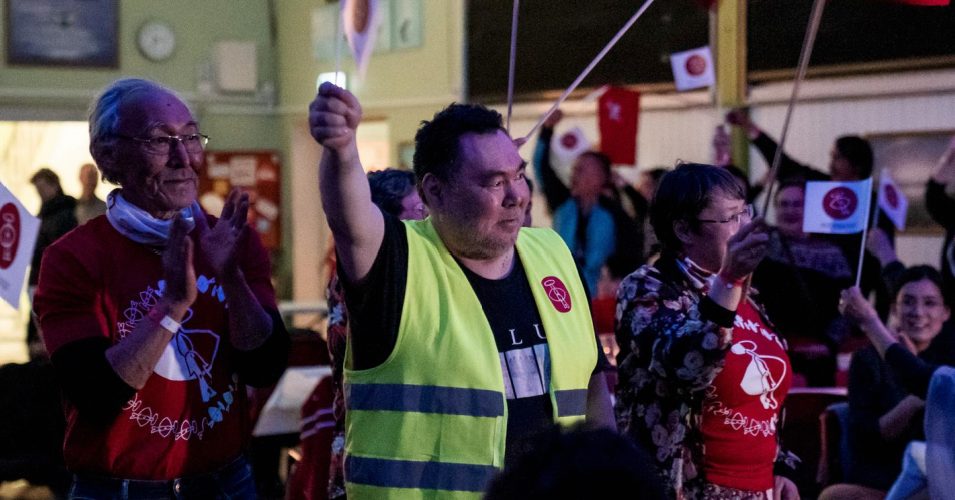
![The Long Shadow of the Tar Sands: Lithium Mining and Tar Sands Sulfur [Dispatches from Thacker Pass]](https://dgrnewsservice.org/wp-content/uploads/sites/18/2021/04/Shadows-980x652-1.jpg)
